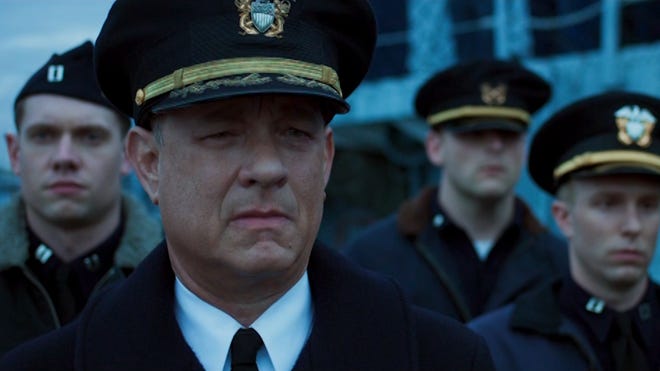Hollywood is running out of ways to do war movies. Studios have approached telling war stories in every conceivable way: epic, subdued, masculine, romantic, accusatory, reflective, victorious and mournful. One moment there’s The Bridge on the River Kwai and the next there’s Paths of Glory. The patriotic manliness of The Green Berets feels incredibly outdated compared to The Deer Hunter, and even that seems pedestrian by the time The Thin Red Line gets released. Even as recently as last year, there’s a wildly different mood between 1917 and Jojo Rabbit. So how many aspects of war can be dramatized before it becomes routine, no matter how dignified or professional any movie can be?
Despite its star’s best wishes, Greyhound would seem like an oddity to be in theaters during the summer movie season. It’s 1942 and Ernest Krause (Tom Hanks) is about to take on the biggest challenge of his life: commanding a naval destroyer. Not only that, but his USS Keeling (codename Greyhound) is in charge of escorting an Allied convoy of supplies across the Atlantic. On top of maintaining a poise amongst his fellow officers, Krause must protect the convoy and his ship from German U-boats circling around his ships.

Photo Credit: Sony Pictures
Greyhound seems like old school entertainment, a war movie with a singular setting and a singular star carrying the picture. It’s certainly based on old school entertainment, being adapted from the 1955 novel The Good Shepherd by Hanks himself, and director Aaron Schneider (Two Soldiers, Get Low) keeps about 98 percent of the movie locked onboard the titular vessel. Those old-school ideas don’t really blend with modern entertainment standards, though. For one thing, Greyhound has dialogue more focused on the technicality of naval warfare than interesting character development. The movie is so locked into its own battle scenes and Hanks looking out into the CGI sea with concern that all the coordinates and orders for rudder turns can be numbing after a while. There’s little to no detail given to the rest of the crew of the ship, while Krause only gets one scene off the ship with a token love interest (nice to see you, Elisabeth Shue) to show a softer side. Greyhound has all the technical details down pat, especially in the sound department. Schneider’s sound design team makes every gunfire and wave crash effective while the score by Blake Neely (You, The Flash) ramps up with tension by mimicking sounds of a boat taking heavy fire. Still, technical competency can only liven up a boring story so much.
Not even Hanks showcases the kind of prestige that can elevate the flat material. While many have pegged Hanks as the modern-day Jimmy Stewart, here he’s putting on his stiffest Clint Eastwood tribute. Hanks has proven many times before he can reserve his kind charm for a more stern performance. It’s not even the first time he’s done that for a war movie (Saving Private Ryan). But Greyhound doesn’t give Krause any personal history to further define him or let him connect to any of the crewmates to show his humanity. It’s even more shocking since Hanks is the one writing the screenplay, yet all he afford his character is the sense of old age creeping up on him and even that is only touched upon briefly. Without anything else to color in his own character’s lines, Hanks just looks like he’s waiting for more direction. He has the poise and the presence of a leader for sure, but someone else needed to give him more to follow.
Even for a work of historical fiction, Greyhound feels more like a documentary shown in high school history classes than any form of entertainment. It’s a technically sufficient film but lacking in any excitement or creativity. However passionate Hanks may be about the source material, his latest foray into World War II is missing an energetic heart driving its purpose. War is hell; it’s certainly not meant to be boring.
Advertisement







